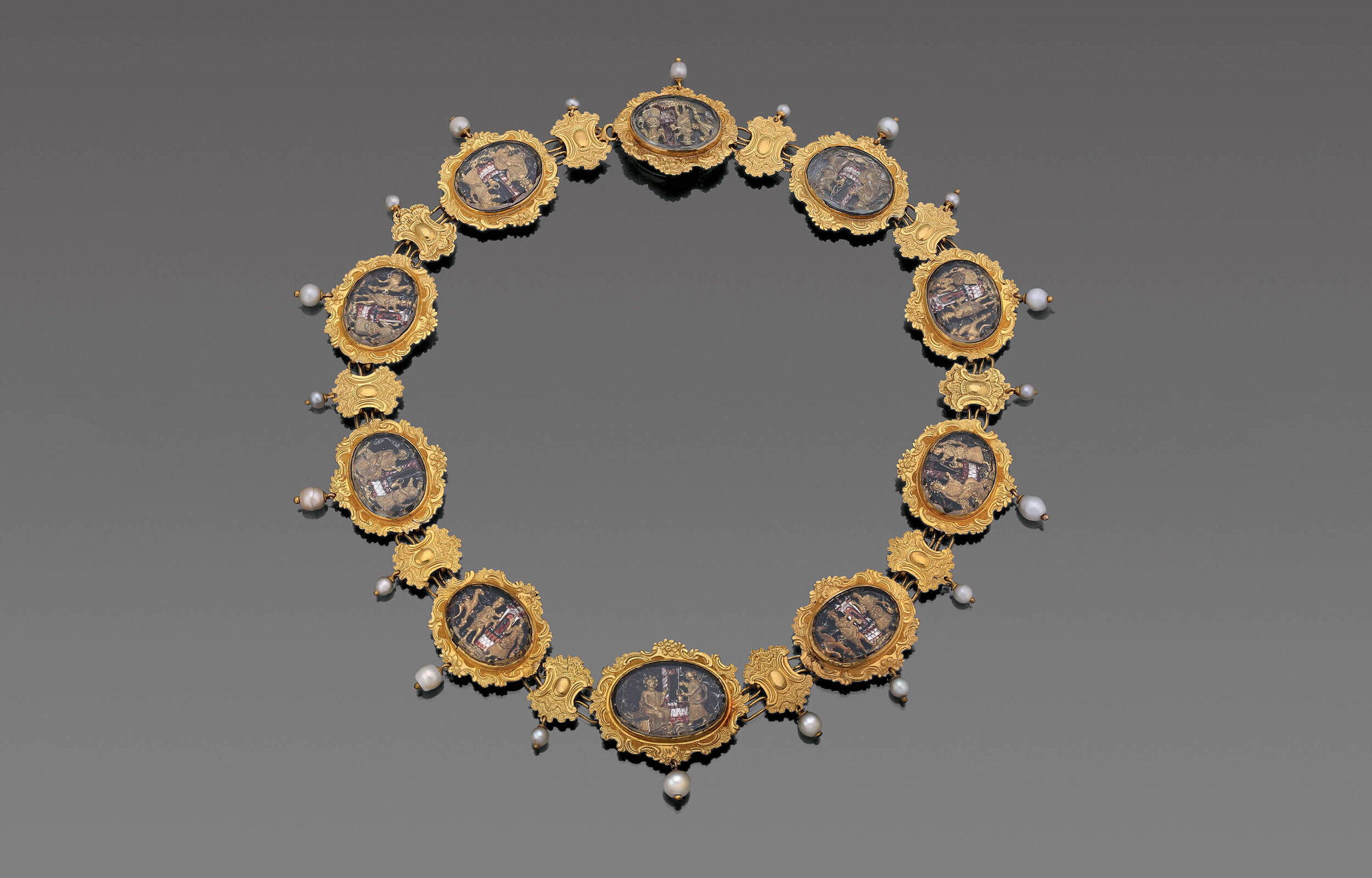Seldom do we come across such an early and elaborately decorated example of a bootjesketting, a typically Dutch jewel. Bootjeskettingen are delicate necklaces and of the earliest examples, not many have survived. Only one other early example like this one is known.
This exceptional necklace was made in the Netherlands between 1740 and 1760. It’s made from gold, silver, crystal glass and pearls. The necklace is made up of ten oval medallions with gold settings of asymmetrical rocailles and floral motifs on a matt ground. The medallion centre front is slightly larger than the others. Behind facetted crystal glass alternating biblical scenes from the Old Testament are pictured in the medallions. One shows Rebecca at the well and the other the Samaritan woman at the well. Between each medallion there is a gold ornament made entirely of stratified rocailles with a plain, convex, oval field in the centre. All the parts are held together with oval links. Natural pearls hang from the medallions and the ornaments.
Rare and Early Necklace
Bootjesketting
Gold bootjeskettingen are typically Dutch jewels that were made in the Netherlands from the beginning of the eighteenth century. They appeared chiefly in Friesland, Groningen and Holland. The term is used for necklaces consisting of oval gold or silver ‘boats’ often in a filigree setting, connected with links. Generally speaking, the oval links are set with a garnet, but we also know examples with amethyst, citrine, peridot and different colours of glass.
Most bootjescolliers we know now date from the nineteenth and twentieth centuries and they are much simpler in execution than this example. To date, only one other eighteenth century example, with a comparable elaborate arrangement is known; it is in the Amsterdam Museum’s collection. It was made around the same period and the biblical scenes depicted are identical to those of the necklace pictured here, and the settings are also very alike. Although both unmarked, it would seem that they are by the same hand. The earliest known, much simpler example of a bootjesketting dates from 1722 and is part of the collection of the Rijksmuseum.
Boite à portrait
The term boat in the name bootjesketting is probably basterdised from the French word boîte, derived from a ‘boîte à portrait’. A boîte à portrait was originally an oval miniature portrait of the French king Louis XIV, in a costly setting with precious stones. He had the medallions made as diplomatic gifts.
Rebecca at the Well
In five of the links in this necklace we see Rebecca, standing to the right of a well. Beside her stands Abraham’s steward, with two camels to his left. It is the story in Genesis 24 that relates how Abraham’s steward was sent to Mesopotamia to find a wife for the aged Abraham’s son Isaac in the family of Abraham. When he arrives there as dusk falls, he stops by a well to give his camels water. He prays to God to let him make the right choice and decides that the woman who offers him a drink from her own water jar will be the right wife for Isaac. The first woman to approach is the beautiful Rebecca. He may drink from her jar. She even offers to fetch water for his camels and at that moment he knows he has found the right woman. They leave right away and when they reach Canaan, she marries Isaac and they have a long and happy life together.
A Samaritan Woman at the Well
The story of the Samaritan woman at the well comes from the gospel according to John chapter 4 in the New Testament. The story recounts how Jesus, who is on the way with his disciples from Judea to Galilee, stops by Jacob’s well near the town of Sichar. While his disciples go to the town to buy food, Jesus rests by the well in the hottest part of the day. A Samaritan woman also stops at the well to draw water. Jesus asks her for water. She is astonished that a Jew would ask her for water, since the Jews and the Samaritans have no dealings. And how can he know that she has already had five husbands? The Samaritan woman recognizes Jesus as a prophet and brings her fellow villagers to the well. He says ‘Anyone who drinks this water will soon become thirsty again. But those who drink the water I give will never be thirsty again. It becomes a fresh, bubbling spring within them, giving them eternal life.’
Wedding Present
Since the story of Rebecca at the well is the most detailed description of an arranged marriage in the Bible, this necklace may very well have been a wedding gift.

